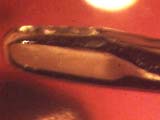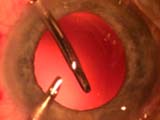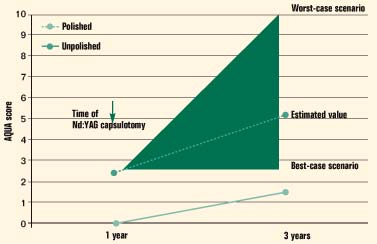Extensive polishing of anterior capsule does not reduce PCO, according to surgeons
But eyes polished to remove lens epithelial cells appeared to have more homogeneous PCO than unpolished eyes.
MUNICH — Extensive polishing of the anterior capsule following cataract removal does not decrease the rate of posterior capsule at opacification, according to a study presented here.
Matthias Wirtitsch, MD, and Rupert Menapace, MD, conducted the prospective, randomized study with colleagues at the University of Vienna, Austria.
In the study, patients underwent bilateral cataract surgery and implantation of round-edge silicone IOLs, with the anterior capsule of one eye of each patient polished before IOL implantation.
“This study shows that anterior capsule polishing does not prevent formation of PCO and might even allow for more regeneratory cataract. We do not suggest polishing the anterior capsule after cataract removal with these types of lenses,” Dr. Wirtitsch told Ocular Surgery News.
However, he said, in cases with excessive propensity for rhexis contraction, such as myotonic dystrophy, anterior capsule polishing may be advisable because it offers some advantages that may outweigh the disadvantage of edge barrier failure.
Randomized study
Images: Wirtitsch M |
The study, designed as an intra-individual comparison, included 96 eyes of 48 patients with bilateral age-related cataracts, 32 women and 16 men. Standard, bilateral cataract surgery using a 3.5-mm incision and in-the-bag IOL implantation was performed by Prof. Dr. Menapace in all cases.
Fifty-two patients were initially enrolled and randomized. Half were bilaterally implanted with the Advanced Medical Optics SI40 lens and half were bilaterally implanted with the Silens 6 lens (Bausch & Lomb). Both lenses are round-edge silicone IOLs with open loops.
Before lens implantation, the anterior capsule of one eye was extensively polished using the Menapace aspiration curette (Geuder), which Prof. Menapace designed specifically for anterior capsule polishing. The fellow eye received only standard cataract surgery.
One week postop, three patients in the SI40 lens group and one patient in the Silens 6 lens group were excluded due to declined follow-up or need for another IOL type.
Over 3 years follow-up, another eight patients in the SI40 group and three patients in the Silens group were lost due to death or immobility.
PCO was evaluated using standard coaxial retroillumination photography at 1 and 3 years and graded using the Automated Qualification of After-Cataract (AQUA) automated image analysis system. Nd:YAG capsulotomy rates were also considered.
At study completion, 15 patients remained in the SI40 group and 22 were in the Silens group.
Study results
According to the study, extensive polishing of the anterior capsule did not help prevent PCO formation.
At 1 year follow-up, no PCO that required capsulotomy was seen in the polished or unpolished eyes of either lens groups.
However, between 1 year and 3 years follow-up, four of the polished eyes in the SI40 lens group required capsulotomies and another one eye required a capsulotomy at 3 years.
After 3 years follow-up, two of the unpolished eyes in the SI40 lens group required capsulotomies.
Among eyes implanted with the Silens 6, five of the polished eyes required capsulotomies between 1 year and 3 years follow-up, and eight eyes required capsulotomies after 3 years.
Two of the unpolished eyes in the Silens group required capsulotomies between 1 and 3 years follow-up and seven required it after 3 years.
Overall, 18 of the polished eyes required capsulotomies compared to 11 of the unpolished eyes.
Six patients received Nd:YAG capsulotomies in both eyes.
Dr. Wirtitsch added that morphologic differences in PCO were observed between polished and unpolished eyes. PCO in polished eyes appeared to be more homogeneous, while in unpolished eyes there was a greater propensity to form well-defined pearls. Accordingly, visual acuity in polished eyes did not decrease to the same extent as in unpolished eyes.
Estimated PCO rates
Dr. Wirtitsch said the study was originally planned for 3 years follow-up. However, before the study was completed, Nd:YAG capsulotomies had already been performed in several patients, which presented the researchers with a statistical problem. “We did not have the 3-year AQUA scores for PCO in those eyes that already had Nd:YAG capsulotomies, so we had to estimate the AQUA scores,” he said.
The estimation was performed three different ways, providing estimations of PCO rates in three different scenarios.
In the first estimation, the best-case scenario, AQUA scores from just before capsulotomy were taken and carried forward to the end of the study. In the second estimation, the worst-case scenario, the maximum AQUA score of 10 was used, which basically assumed PCO would have increased to the maximum grade possible.
In the third estimation, Dr. Wirtitsch and colleagues increased the AQUA score from 1 year to 3 years at the same rate experienced from 6 months to 1 year.
“These statistical estimations do certainly not show the real AQUA score, but it must be somewhere in between the best-case and the worst-case scenarios,” he said, noting there was no statistically significant difference in any of the estimated values between polished and unpolished eyes.
| Estimation of PCO score after capsulotomy |
For patients who underwent Nd:YAG capsulotomy before the 3-year follow-up point, the 3-year AQUA score was estimated using three methods: Best case scenario was based on AQUA score from just before the capsulotomy, carried forward to 3 years; worst-case scenario was an AQUA score of 10, assuming PCO would have progressed to the maximum grade possible; a third estimation used the rate of progression from 6 to 12 months to project the score at 3 years. Source: Wirtitsch M |
Anterior capsular fibrosis
Although there were no significant differences in PCO rates between polished and unpolished eyes, Dr. Wirtitsch said polishing of the anterior capsule may have caused more regeneratory PCO due to decreased anterior capsular fibrosis.
He said anterior capsule fibrosis is needed to maintain a permanent seal between the anterior and posterior capsule along the edge of the IOL optic.
“Only a firm fibrotic seal at the optic edge provides an effective and permanent barrier against migrating lens epithelial cells,” he said.
Dr. Wirtitsch said capsular fibrosis is affected by polishing of the capsule because there are two types of lens epithelial cells (LECs): anterior and equatorial.
Anterior LECs are located at the anterior capsule and transdifferentiate into myofibroblasts, causing fibrosis of the capsule.
After lens removal, some of the equatorial cells remain in the equatorial region of the capsule. These cells can then proliferate and migrate between the IOL and the posterior capsule, forming regeneratory cataracts.
“State-of-the-art IOL designs exhibit a sharp posterior edge that prevents migration of these equatorial LECs by creating a sharp bend in the posterior capsule when wrapped around during capsular bag sealing,” Dr. Wirtitsch said. “But the barrier against migrating cells is permanent only if there is a firm fibrotic seal between the anterior and posterior capsules. If anterior LECs are removed through polishing, that fibrotic seal is no longer sufficient.”
For Your Information:
- Matthias Wirtitsch, MD, can be reached at AKH Wien Augenklinik, Währinger Gürtel 18-20, A-1090 Vienna, Austria; +43-140-400-7944; fax: +43-140-400-7944; e-mail: matthias.wirtitsch@akh-wien.ac.at.
- Prof. Dr. Rupert Menapace, MD, is the designer of the Menapace aspiration curette, and a corresponding author of the study. He can be reached at AKH Wien Augenklinik, Währinger Gürtel 18-20, A-1090 Vienna, Austria; fax: +43-140-400-6630; e-mail: rupert.menapace@univie.ac.at.
- Geuder AG, makers of the Menapace aspiration curette, can be reached at Hertzstrasse 4, D-69126 Heidelberg, Germany; +49-6221-3066; fax: +49-6221-303-122; e-mail: info@Geuder.de; Web site: www.geuder.de.
- Michael Piechocki is an OSN Staff Writer who covers ophthalmology in Europe and the Asia-Pacific region. He also specializes in oculoplastics coverage.



